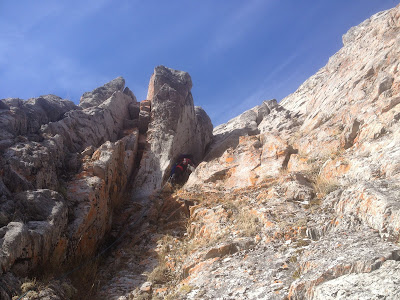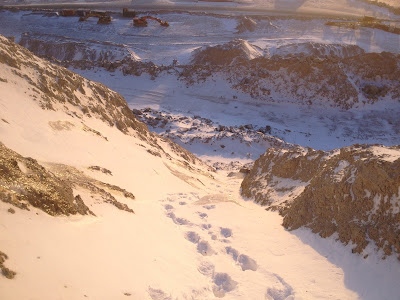 |
| Click on this because maybe it looked like something? You were mistaken. As the helmetless Mr. Panepinto demonstrates, the East Fork Solomon Crags amounts to nothing more than a mossy turdpile. You succumbed to "Tale of Topographic Oceans Syndrome." |
Tales of Topographic Oceans Syndrome (TOTOS): the tendency of a low-quality rock outcrop to gain in value due to its isolation from other rock outcrops.
 |
| Birmham, Lands End, Treen, Avebury, Stonehenge... the album cover for the Vedic concept album "Tales of Topographic Oceans." |
Is this a type of "Prominence" criteria for boulders and crags, similar to the one developed for big mountains? If it were, the crags at East Fork of Solomon River would score well because of the way they stand so starkly alone on the tundra landscape, the irony being that if you hike a few hundred feet up the hill and get right up close to these crap rocks, they turn out to be composed of the utter, utmost, shittily-schistleton choss that the Seward Peninsula can dish up.
 |
| James underneath, and dangling from, trigger-happy tons of schist. Arctic Crankloon, 5.4d. |
2015 saw two, good old-fashioned exploratory trips to the East Fork Solomon crags, easily visible from the Teller Road all my years, but never visited. After a long period of climbing at the same old crags around Nome over and over again, it sure felt nice to experience the familiar pattern of sensations that come with first visit to a new clump of rocks: the uncertainty of where to park (in the case of East Fork Solomon, a gravel pullout right down by the river), followed by the hike up to what hopefully will be a cornucopia of climbing, as the rocks gradually unfold upon approaching them and open up like russian dolls to become more than what they appeared from the road.
Or, as in the case of the East Fork Solomon crags, less than what they appeared. TOTOS ("Tales of Topographic Oceans Syndrome") had created a mirage. These mystery crags had appeared like something off a Roger Dean-inspired album cover of an eighties progressive rock band, but the reality up close was a bad glue job of fragmented schist chunks and turf.
 |
| A living, breathing chimney amidst the schist |
First trip with David, we took no ropes. The month was June, Solstice time, the air heavy with flowers, the warm wind making us lazy. The only stone we found worth returning for was the Crankloon, the largest clump of E-Coli-shaped fecal matter among several dollops of fecal matter scattered on the ridge, metamorphic, the whole pile. The Crankloon boulder sported a 23-foot south wall with an actual crack (that precious commodity of schist climbing) that I could almost solo, but chickened, so decided to come back some other time with a rope.
 |
| Crankloon |
Second trip with James, we carted a sack full of paraphernalia up the short hill to the crag. On the way up, James probably imagined we had penetrated to a fantasy climbing area from his wildest arctic dreams, where surreal spires rose improbably from green hills by a twinkling sea. A fantasy area is what the East Fork Solomon Crags appears to be, at first. But James had succumbed once again to "Tales of Topographic Oceans Syndrome," and only raw choss awaited him.
The climb was so short and rotten, I felt rather foolish having driven all the way from town for it, and as the ropes and cams and pins poured out of our rucksacks, enough gear to do a small wall, I felt more foolish still.
Just to lead the crack, I chickened. So we top-roped, and played around, and James added variations up to 5.4d on the schist that seemed to dripping down at a geological rate like a slow fungus.
 |
| Crankloon |
Let us assign x number of negative points to East Fork Solomon Crags for scabrous choss factor. Fair enough. But one descriptor left out of far in this assessment is beauty— the sad, ridiculous beauty of the spot, the stark, lone, level tundra thrown into relief by tors sticking up invitingly on the horizon, the blue lens of ocean on the other horizon, and moat beauteous of all, the invisible SINH TALA energy of the earth streaming up through the crust so copiously you can hear the white-noise sound of it if the wind is down. So, let us assign y number of positive points for the beauty of the East Fork Solomon Crags.
Here's the thing: x < y This is the very enzyme action of T.O.T.O. Syndrome itself, turning a crap crag into gold through the rendering process of beauty. Were the East Fork Solomon Crags located in California they would be nothing, figuratively and literally. As distinct rock entities, they would not garner enough perception from climbers to carry any psychic weight. California has such an abundance of rock, the Solomon Crankloon would not stand out as worthy of notice in any way. In California, they'd probably just bulldoze a piece of schist like the Crankloon out of the way...
But here on the coast of the Norton Sound, tucked into the subsistence, gold, and reindeer country between Council and Nome, the East Fork Solomon Crags are a gold medal finalist of a Beringian rock garden. James is probably telling his friends about the killer bouldering he did at the fantasy climbing area in Alaska. I am spraying to my friends about my 5.5b "proj", confident they are paying no attention to what I am saying. The abundant flows of SINH TALA earth energy in the region, combined with an absence of psychic interference from any appreciable human population in the surrounding area, plus the harmonizing influence of massive beauty, amplify the psychic power of the stone arrangement into a sum that is greater than its choss.
Stand on hills of long forgotten yesterdays
Pass amongst your memories told returning ways
As certain as we walk today
Press over moments leaving you
Out in the city running free
Days pass as seconds turn the key
The strength of the moment lies with you
Out tender outward lights of you
Shine over mountains make the view
The strength of you seeing lies with you
Yes |
 |
| Lucy at Solomon |
Franklin Johnson, engineer, stampeder, grunt, late of the Alaskan goldfields at Nome and Council, former graduate of the Dresden Polytechnikum, and contemporary of Perry Smith and Fehrmann on the sandstone climbs of the Elba River banks, tried to spit, but his mouth was too dry.
Dry. One plaintive thought in Johnson's mind. There'll be water at East Fork. Then: Sure gotta hate sledging a load in the summertime. But there was nothing else for it. He had to get this axle over to Big Hurrah, and pronto, too, and there sure as hell wasn't no diggety train gonna haul the thing over. So man haul it was.
At the East Fork of the Solomon River he drank his fill, then had a little snooze in the sun, though the breeze dropped at the end and the bugs woke him up. A little venison, and then...
Johnson noticed the rock outcrop a short ways up the hill. His known eccentricity of climbing the rocks held no witness this time, other than a family of bears and two foxes. Johnson ambled up to the hill for some klettern on what he hoped would be some good stone.
But when he got up to the rocks, Johnson took one look and, without even bothering to mount a hold, spat on them, successfully this time. The rock was of a kind that Fehrmann would have blurted, "Scheiss!" Johnson had an appointment with a 100 lb. sledge down and seven more miles of muddy road. He made a mental note of the crags and started down the hill.







































